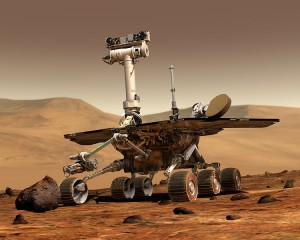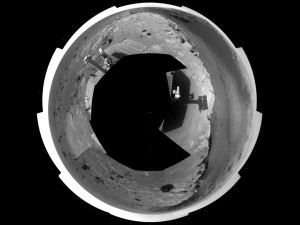Roblog is a weekly column dedicated to understanding the world of robotics. If science fiction is right and the impending robot apocalypse is real, it can’t hurt to be prepared. Come back every Wednesday for a new blog of robot rants.

Two things almost inseparably associated with futuristic visions are robots and space. And why not? Space is one of humankind’s final frontiers. If more habitable planets are found outside our solar system, current problems of global warming and rapid population growth change completely. Much to the dismay of science and space-lovers alike, humans can’t yet live in outer space to figure it out, especially when so little about resources in space is known. Luckily, thanks to robots, understanding space isn’t an impossibility. By giving robots monitoring capabilities and sending them out into space for us, scientists might be able to answer questions about whether space could sustain humans in the future.
This is exactly the goal of NASA’s Mars Exploration Rover Mission (MER). MER began with a 90 day mission in 2003 when two rovers, called Spirit and Opportunity, were sent to Mars to explore the red planet. Given the task of finding clues about whether Mars shows any signs of being habitable, both rovers are equipped with specialized tools that allow them to survive alone on Mars as well as monitor their surroundings very carefully. Each rover has three different spectrometers that allow them to seek out and identify minerals that might show signs of water or life. They are also both equipped with two cameras. The first, a microscopic imager, allows geologists back on Earth to take a closer look at rock and soil formation. The second is panoramic and gives scientists an idea of where to send the rovers (and provides for some pretty amazing pictures, too).

What’s even more amazing about these space robots, however, is their incredible resiliency. After the initial 90-day mission was a success, the robots’ time in space was extended several times over. Now, nearly nine years after the April 2004 completion of the initial mission, Opportunity is still going strong. Unfortunately, after getting stuck in a sand trap and having some software problems, NASA lost communication with Spirit in March of 2010 and has since abandoned hope of contact. Spirit was still a success, though, because it had already taken hundreds of thousands of pictures and sent valuable information back to NASA about the planet’s soil composition.
Opportunity’s story continues to be even more of a success. It has traversed craters, traveled over 21 miles through dust storms and harsh winds, and still has all of its instruments and wheels intact. It was even the first rover to find evidence of gypsum, a mineral often found near running water. Its most recent mission was a journey from Victoria Crater to its current location at Endeavor crater (shown in the video below), where scientists hope it will find more information about Mars’ past and uncover secrets about our future.
On Earth, there are plenty of reasons to be afraid of robots. Safely out on Mars, however, conducting research of which humans are incapable, there’s no doubt as to the importance of robot rovers like Spirit and Opportunity. Spirit may be retired, but Opportunity could be our greatest hope of finding definitive evidence of whether Mars can support life. To that, I say, “Go robots, go!” After all, who wouldn’t love to live in space with robots? Just me?
Interested in keeping up with these rovers? Follow the mission on Twitter or check out NASA’s mission page for more information.


One Comment on “Roblog: The Little Space Bots That Could”